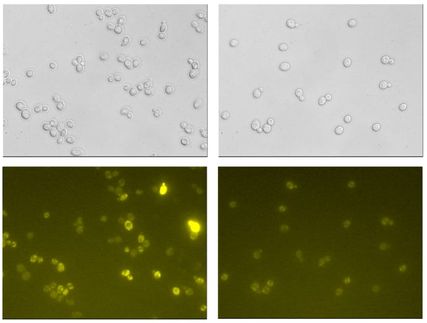MIT: New cell measurement system
New system could shed light on how cells control their growth
Using a sensor that weighs cells with unprecedented precision, MIT and Harvard researchers have measured the rate at which single cells accumulate mass — a feat that could shed light on how cells control their growth and why those controls fail in cancer cells.
The research team, led by Scott Manalis, MIT associate professor of biological engineering, revealed that individual cells vary greatly in their growth rates, and also found evidence that cells grow exponentially (meaning they grow faster as they become larger).
The new measurement system, reported in thNature Methods, is the first technique that can measure cells' mass as they grow over a period of time, ranging from five to 30 minutes. Previous methods for measuring cell growth rates have focused on volume or length measurements, and have not yet exhibited the necessary precision for revealing single cell growth models.
The cell-mass sensor, which Manalis first demonstrated in 2007, consists of a fluid-filled microchannel etched in a tiny silicon slab that vibrates inside a vacuum. As cells flow through the channel, one at a time, their mass slightly alters the slab's vibration frequency. The mass of the cell can be calculated from that change in frequency, with a resolution as low as a femtogram.
Michel Godin, a former postdoctoral associate in Manalis' lab and co-lead author of the paper, developed a way to trap a cell within the microchannel by precisely coordinating the flow direction. That enables the researchers to repeatedly pass a single cell through the channel every second or so, measuring it each time it moves through.
The researchers studied four types of cells: two strains of bacteria (E. coli and B. subtilis), a strain of yeast and mammalian lymphoblasts (precursors to white blood cells). They showed that B. subtilis cells appear to grow exponentially, but they did not obtain conclusive evidence for E. coli. That's because there is so much variation between individual cell growth rates in E. coli, even for cells of similar mass, says Francisco Delgado, a grad student in Manalis' lab and co-lead author of the paper.
If cells do grow exponentially, it means there must be some kind of mechanism to control that growth. Otherwise, when cells divide into two slightly different-sized daughter cells, as they often do, the larger cell in each generation would always grow faster than the smaller cell, leading to inconsistent cell sizes.
"If there were no control over the process, the variation in cell size would be all over the map," says Marc Kirschner, professor of systems biology at Harvard Medical School and an author of the paper. However, biologists don't know yet how that control mechanism might work.
In their current studies, the researchers are tagging proteins inside the cell with fluorescent molecules that reveal what stage of the cell cycle the cell is in, allowing them to correlate cell size with cell cycle position. They are also working on a way to add chemicals such as nutrients, antibiotics and cancer drugs to the fluid inside the microchannel, so they can study how those substances affect growth rates.
Original publication: Michel Godin, Francisco Feijo Delgado, Sungmin Son, William Glover, Andrea Bryan, Amit Tzur, Paul Jorgensen, Kris Payer, Alan Grossman, Marc Kirschner and Scott Manalis; "Using buoyant mass to measure the growth of single cells"; Nature Methods 2010.
Organizations
Other news from the department science

Get the life science industry in your inbox
By submitting this form you agree that LUMITOS AG will send you the newsletter(s) selected above by email. Your data will not be passed on to third parties. Your data will be stored and processed in accordance with our data protection regulations. LUMITOS may contact you by email for the purpose of advertising or market and opinion surveys. You can revoke your consent at any time without giving reasons to LUMITOS AG, Ernst-Augustin-Str. 2, 12489 Berlin, Germany or by e-mail at revoke@lumitos.com with effect for the future. In addition, each email contains a link to unsubscribe from the corresponding newsletter.



















































